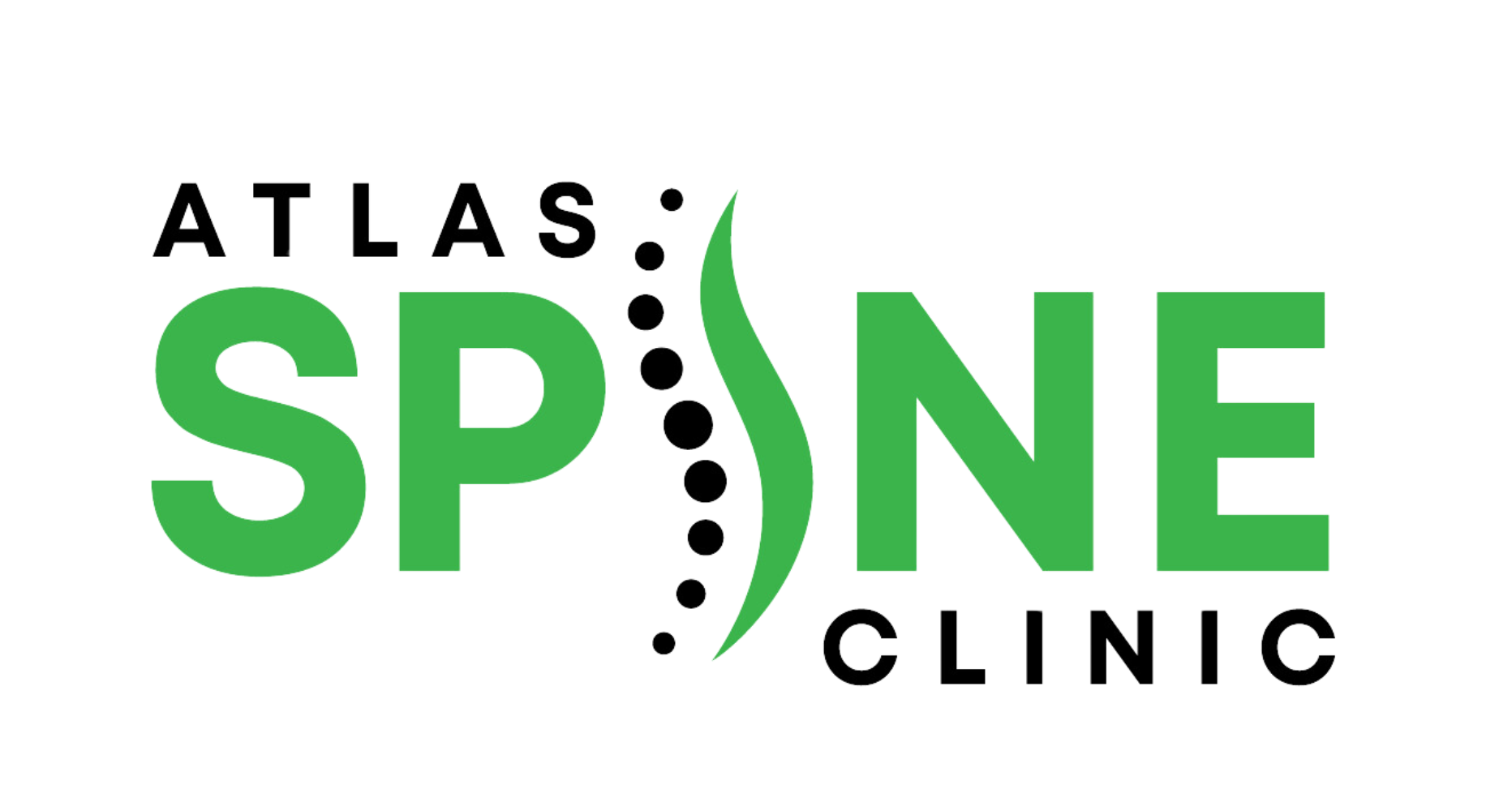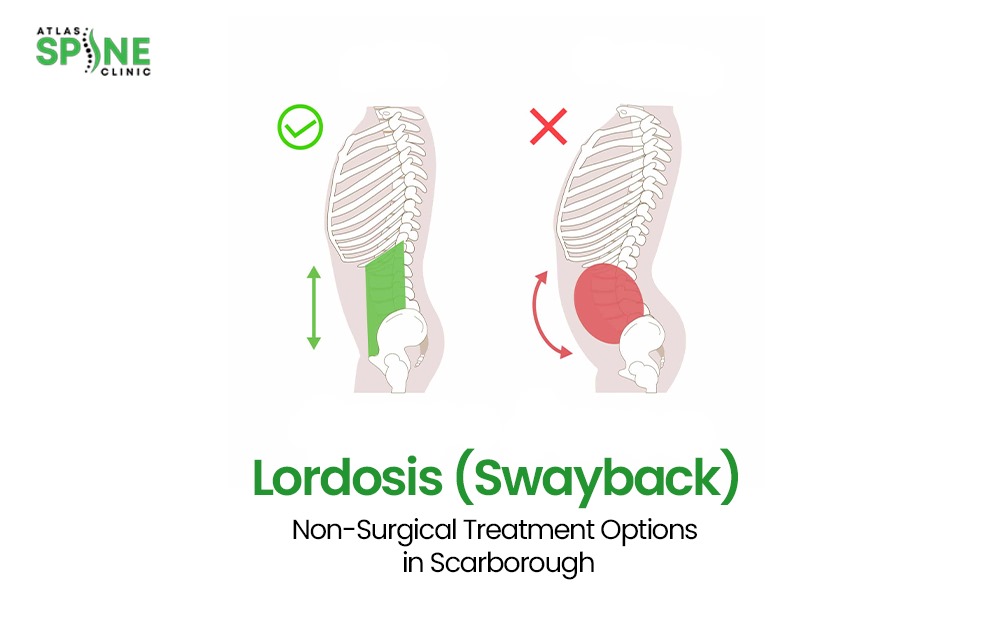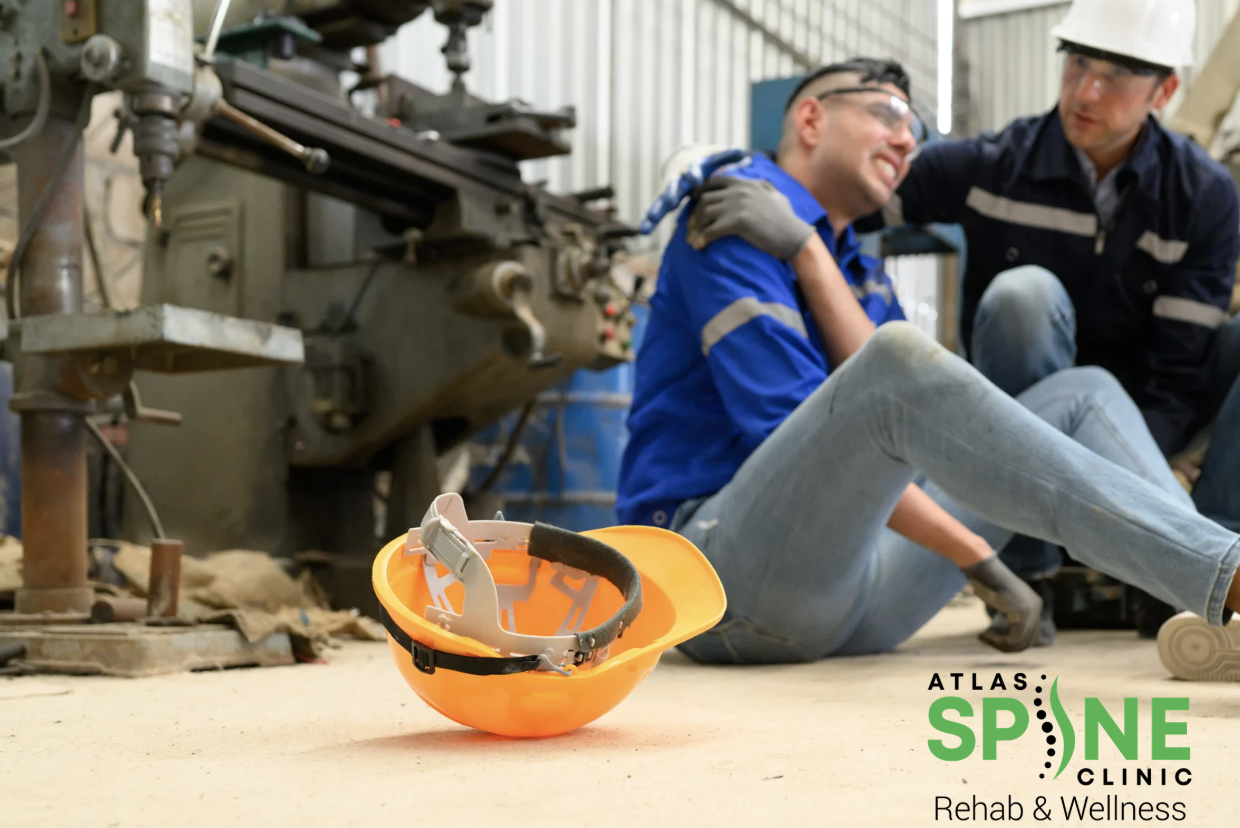Why Talking About Lordosis (Swayback) Matters
If your lower back arches a little too much, that’s usually lordosis, also called swayback posture. The lumbar spine is supposed to curve forward just enough to balance your posture. Once that spinal curvature deepens, your hips push ahead, your belly sticks out, and the strain becomes real.
This isn’t just a “posture thing.” It can throw off confidence, limit your moves, plus pile stress on your spine health. Fixing it isn’t about a quick hack, it’s about steady effort with the right plan. That’s why more people are leaning on non-surgical spine treatment with local Lordosis treatment options in Scarborough to reset alignment as well as stay active without the pain.
What Is Lordosis (Swayback)?
Think of your spine like a springy column. It isn’t straight. It has built-in curves to help you move smoothly as well as absorb shock. In your neck (cervical spine) and your lower back (lumbar spine), the curve bends slightly forward. That’s called lordosis, which is completely normal.
The trouble starts when that curve gets too deep. That’s when we call it hyperlordosis or swayback. The low back arches harder than it should, the pelvis tips forward, plus the body shifts out of balance.
How it stacks up against other curves:
- Lumbar lordosis → the natural inward curve of your lower back.
- Cervical lordosis → the same forward curve, but in your neck.
- Kyphosis → the opposite curve, bending backward in your upper back.
- Scoliosis → a sideways twist that rotates the spine.
Evidence with the Spine Anatomy:
- “Lumbar curvature approximately measures 40-60 degrees; greater angles define hyperlordosis”.
- “Cervical spine typically holds a 30-40 degree inward curve; beyond this, posture may become symptomatic”.
Causes of Lordosis You Should Know
Several factors shift posture from normal to swayback.
| Category | Key Causes | How It Contributes |
| Musculoskeletal Imbalances | Tight hip flexors, weak glutes and core | Tilts pelvis forward and locks curve in place |
| Lifestyle Habits | Long hours sitting, poor posture, high heel use | Reinforces anterior pelvic tilt and posture distortion |
| Weight Factors | Obesity | Adds pressure on the lumbar spine |
| Spine Conditions | Spondylolisthesis, disc changes, osteoporosis | Alters vertebral alignment and stability |
| Life Stages | Pregnancy, childhood growth, congenital conditions | Temporary or developmental shifts in spine health |
An additional note: Postural issues plus musculoskeletal imbalance often feed into anterior pelvic tilt. This tilt amplifies lumbar load, gradually showing up as swayback posture.
Signs and Symptoms of Lordosis
Your body usually drops hints before lordosis feels serious. The most obvious? That deep swayback stance. The hips push forward, the stomach sticks out, and the curve looks sharper than usual.
Other common signs:
- Protruding abdomen or buttocks
- Lower back pain that shows up after standing or sitting too long
- Stiffness, reduced or issues with mobility when trying to bend or twist
- Tingling or numbness linked to nerve compression
- Extra space under your lower back when you lie flat on the floor
- Changes in posture.
Red flags you should not ignore:
- Progressive weakness in the legs or arms
- New bladder or bowel changes
- Severe neurological symptoms
These warning signs mean it’s time to get checked quickly instead of waiting it out.
Non-Surgical Lordosis Treatment in Scarborough
Not every curve needs surgery. In fact, most swayback cases respond well to a mix of hands-on care, guided exercise, plus a dash of smart lifestyle tweaks. The goal is simple: reduce pain, restore mobility, and stop the curve from progressing.
Here’s a snapshot of the main non-surgical options available locally:
| Treatment | Approach | Visit Cadence | Expected Outcomes |
| Chiropractic care | Spinal adjustments, restoring segmental motion | 1–2 sessions weekly, tapering over months | Improved mobility, reduced stiffness |
| Physiotherapy in Scarborough | Core/glute sequencing, motor control, posture retraining | 1–2 times weekly | Posture reset, strength balance |
| Massage therapy in Scarborough | RMT soft tissue release for paraspinals, hip flexors, QL | Weekly or bi-weekly | Muscle relaxation, reduced pain |
| Acupuncture Scarborough | Needle therapy, sometimes electro-acupuncture | Weekly | Pain modulation, muscle tone balance |
| Osteopathy in Scarborough | Whole-body joint balance, soft tissue therapy | Weekly or as needed | Enhanced circulation, smoother mobility |
| Custom orthotics | Foot arch support, pelvic alignment | Daily wear | Better posture control, gait support |
What to expect: Most people notice changes within weeks, especially in pain levels and flexibility. Postural correction takes longer, usually requiring months of consistent care, in addition to follow ups with specialists. Providers often recommend reassessment every 3-6 weeks to track progress.
When to pause or refer out: If neurological red flags appear, such as bladder changes, weakness, or severe nerve compression, treatment shifts toward urgent medical referral instead of conservative care.
Evidence spotlight: Studies confirm that strengthening the core as well as retraining posture through physiotherapy are the most effective non-surgical ways to manage hyperlordosis. Hands-on therapies like chiropractic care or massage add relief by restoring motion whilst reducing muscle tension.
At Home Exercises for Lordosis Management
Physiotherapy exercises are one of the best tools for taking control of swayback outside the clinic. The goal isn’t to erase the curve overnight. It is to strengthen the right muscles, release the tight ones, whilst teaching your body how to hold itself in better alignment. Done consistently, these moves make a real difference.
Here’s a starter set you can safely try:
| Exercise | How to Perform | Benefits |
| Pelvic tilts | Lie on your back, knees bent. Flatten low back into floor. | Resets pelvic alignment |
| Glute bridges | Lift hips with core engaged. Hold 3 sec. | Builds glute strengthening, supports spine |
| Bird-dog | Extend the opposite arm/leg while keeping the spine neutral. | Improves and strengthen core control, posture improvement |
| Cat-Cow | Alternate arching and rounding back slowly. | Boosts spinal mobility |
| Hip flexor stretch | Kneel, shift hips forward gently. | Releases tight hip flexors, aids posture improvement |
How to use them: Aim for 2-3 sets of 10-15 reps, about three times a week. Keep your pelvis neutral, ribs stacked, and move slow. Quality over quantity wins here.
Safety note: Stop if pain appears. If any exercise feels off, check with a physiotherapist before pushing further.
Lifestyle Adjustments to Support Treatment
Exercises do a lot of heavy lifting for swayback, yet the way you live day-to-day either reinforces progress or undoes it. Think of lifestyle modifications as the “silent partner” to therapy; small shifts that stack up big over time.
| Adjustment | Why It Matters |
| Ergonomic workstation | A proper chair, lumbar support, and monitor at eye level keep the spine neutral during long hours. |
| Movement breaks | Short resets every hour break the cycle of stiffness and keep circulation flowing. |
| Weight management | Less load on your lumbar spine means less exaggerated curvature. |
| Footwear advice | Limiting high heels helps prevent anterior pelvic tilt from locking in. |
| Sleep posture | Side or back sleeping with a pillow between the knees promotes spinal health overnight. |
How it all connects: Simple habits like adjusting your desk, adding microbreaks, or swapping shoes with better support make your therapy sessions go further. Even sleep posture plays a role since the right position lets your muscles and joints reset instead of reinforcing the curve.
Special Considerations: Pregnancy & Children
Not every swayback story is the same. Two groups often notice lordosis the most: expecting moms and growing kids.
During pregnancy
As the belly grows, the pelvis tilts and the lumbar spine curves deeper to balance the weight. This is completely natural. The curve usually eases after delivery, yet support during pregnancy matters. Belts, gentle core and glute work, plus safe stretching help keep comfort levels up without stressing the spine.
In children
Kids hit growth spurts fast. Sometimes their spines adapt with a swayback look. Many outgrow it as their bodies catch up, yet certain cases need more than just “waiting it out”. Regular check-ins, growth monitoring, simple physiotherapy, or a brace in rare cases help guide the spine as it develops.
When to get help
- If the curve keeps getting sharper instead of settling
- If pain or stiffness shows up in daily movement
- If neurological signs appear (like weakness or numbness)
The bottom line: pregnancy lordosis is usually temporary, while pediatric spine health often improves with time. Still, both deserve monitoring and frequent safe exercises to make sure the curve stays safe, not harmful.
Your Care Journey at Atlas Spine Clinic
At Atlas Spine Clinic Scarborough, when you walk in with swayback, we don’t just guess what’s wrong. We map out a clear plan. Every step is designed to keep you moving forward, not stuck in the same pain cycle.
Here’s how the journey usually unfolds:
| Stage | What Happens | Timeline |
| Week 1 | First consult: posture check, movement screen, and strength tests. Together we set goals and outline your care plan. | Start point |
| Week 3 | Recheck: track pain levels, mobility gains, and how your spine is adapting. Small tweaks keep progress steady. | Early progress |
| Week 6 | Next review: update exercises, fine tune treatments, and confirm results are sticking. | Midway milestone |
| Beyond | Transition into maintenance: lighter visits, home program focus, and prevention tips so the curve doesn’t creep back. | Long term care |
Why this approach?
- Clear checkpoints so progress never feels vague.
- The method is non-surgical spine care.
- Adjustments in conjunction with exercises evolve with you in a routine designed centred on the patient.
- Care blends therapy in the clinic with strategies you can carry into daily life.
It’s not just about fixing lordosis once; it’s about keeping your spine resilient long term with patient centred care.
Why Choose Atlas Spine Clinic for Lordosis Treatment in Scarborough
We know how much swayback can slow you down. That’s why our approach is built around more than quick fixes. At Atlas Spine Clinic, we focus on evidence based care that blends multiple specialties under one roof so you get a plan that actually sticks.
What sets us apart:
- Integrated team care: Our Scarborough based chiropractors, physiotherapists, massage therapists, osteopaths, and acupuncturists work together instead of separately.
- Accessible location: Find us inside Pharmasave at 21 Glendinning Ave with easy TTC access plus on-site parking.
- Real convenience: Book online, get a free 15 minute consultation, and start with zero guesswork.
- Local trust: Scarborough residents count on us for non-surgical treatment that balances science with hands-on support at a local spine clinic.
We’re not here to chase symptoms. Our goal is to help you move better, feel stronger, and keep your posture in check for the long haul.
FAQs About Lordosis Treatment
Q: Can lordosis be corrected without surgery?
A: Yes. Most cases are managed conservatively. Studies show that exercise therapy, posture correction, and chiropractic care for swayback, or safe lordosis exercises can improve pain and function without surgical intervention. Surgery is reserved for severe deformity or neurological compromise
Q: How long does non-surgical treatment take?
A: Improvements often appear within 6–8 weeks of structured exercise programs, though postural adaptation and strength gains usually require several months of consistency. Evidence from rehabilitation trials confirms that measurable changes in lordotic angle and pain scores occur over this timeframe
Q: What exercises are safe for lordosis?
A: Core stabilization, glute activation, and flexibility routines are supported by research. Exercises like pelvic tilts, bridges, bird-dogs, and hip flexor stretches improve alignment and reduce excessive lumbar curvature safely
Q: Does chiropractic care help swayback?
A: Spinal manipulative therapy, including chiropractic adjustments, has been shown to reduce pain and improve function in patients with mechanical low back conditions. While it doesn’t “cure” lordosis, it can support mobility and symptom control when combined with exercise
Q: Can lordosis return after treatment?
A: Yes, if posture habits or muscle imbalances return. Long term follow up studies on exercise based interventions highlight the importance of continued core training and lifestyle modification to prevent recurrence
Conclusion
Lordosis doesn’t have to run the show. With the right mix of exercise, lifestyle changes, and hands-on support, most people see real improvement without ever needing surgery. The key is consistency. Small steps each week stack up into lasting changes for your posture, mobility, and confidence.
If you’ve noticed that swayback curve getting sharper or the discomfort creeping in, now’s the time to act. Atlas Spine Clinic for Lordosis treatment in Scarborough makes it easier than ever to get started.
Your next move: Book a consultation at Atlas Spine Clinic. Our team is here to guide you through every stage starting from assessment to active care to long term prevention. Let’s get your spine back to moving the way it was meant to.
📞 Call us at (647) 794-6868 or
🖥️ fill out our online form to book an appointment or learn more about our services.






